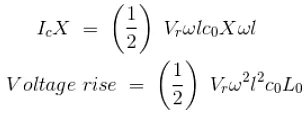Electrical Engineering (EE) Exam > Electrical Engineering (EE) Notes > Power Systems > Ferranti Effect in Transmission Line
Ferranti Effect in Transmission Line | Power Systems - Electrical Engineering (EE) PDF Download
What is Ferranti Effect?
- The Ferranti effect is a phenomenon that describes the increase in voltage that occurs at the receiving end of a long transmission line relative to the voltage at the sending end. The Ferranti effect is more prevalent when the load is very small, or no load is connected (i.e. an open circuit). The Ferranti effect can be stated as a factor, or as a percent increase.
- In general practice we know, that for all electrical systems current flows from the region of higher potential to the region of lower potential, to compensate for the electrical potential difference that exists in the system. In all practical cases, the sending end voltage is higher than the receiving end due to line losses, so current flows from the source or the supply end to the load.
- But Sir S.Z. Ferranti, in the year 1890, came up with an astonishing theory about medium transmission line or long-distance transmission lines suggesting that in case of light loading or no-load operation of the transmission system, the receiving end voltage often increases beyond the sending end voltage, leading to a phenomenon known as Ferranti effect in a power system.
Ferranti Effect in Transmission Line
- A long transmission line can be considered to compose a considerably high amount of capacitance and inductance distributed across the entire length of the line. Ferranti Effect occurs when current drawn by the distributed capacitance of the line itself is greater than the current associated with the load at the receiving end of the line(during light or no load).
- This capacitor charging current leads to a voltage drop across the line inductor of the transmission system which is in phase with the sending end voltages. This voltage drop keeps on increasing additively as we move towards the load end of the line and subsequently, the receiving end voltage tends to get larger than applied voltage leading to the phenomena called Ferranti effect in power system. We illustrate that with the help of a phasor diagram below.

- Thus both the capacitance and inductor effect of transmission line are equally responsible for this particular phenomena to occur, and hence Ferranti effect is negligible in case of a short transmission line as the inductor of such a line is practically considered to be nearing zero. In general for a 300 Km line operating at a frequency of 50 Hz, the no-load receiving end voltage has been found to be 5% higher than the sending end voltage.
- Now for the analysis of the Ferranti effect let us consider the phasor diagrams shown above. Here, Vr is considered to be the reference phasor, represented by OA.

- This is represented by the phasor OC.
- Now in case of a “long transmission line,” it has been practically observed that the line electrical resistance is negligibly small compared to the line reactance. Hence we can assume the length of the phasor Ic R = 0; we can consider the rise in the voltage is only due to OA – OC = reactive drop in the line.
- Now if we consider c0 and L0 are the values of capacitance and inductor per km of the transmission line, where l is the length of the line.
Thus capacitive reactance Xc = (1/ωlc0) - Since, in case of a long transmission line, the capacitance is distributed throughout its length, the average current flowing is,

Now the inductive reactance of the line = ωL0l - Thus the rise in voltage due to line inductor is given by,

- From the above equation it is absolutely evident, that the rise in voltage at the receiving end is directly proportional to the square of the line length, and hence in case of a long transmission line it keeps increasing with length, and even goes beyond the applied sending end voltage at times, leading to the phenomena called Ferranti effect.
The document Ferranti Effect in Transmission Line | Power Systems - Electrical Engineering (EE) is a part of the Electrical Engineering (EE) Course Power Systems.
All you need of Electrical Engineering (EE) at this link: Electrical Engineering (EE)
|
21 videos|108 docs|45 tests
|
Related Searches





















